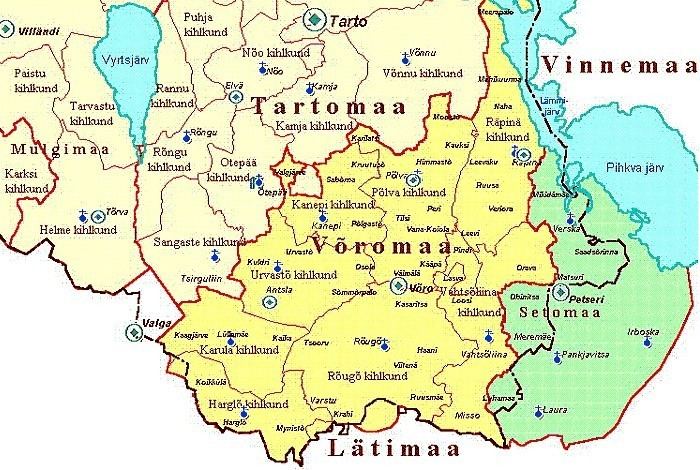Native to Estonia Ethnicity Võros | Region Southern Estonia | |
 | ||
Native speakers 87,000, including Seto (2011 census) Language family UralicFinnicSouth EstonianVõro | ||
The Võro language (Võro: võro kiil' [ˈvɤro kʲiːlʲ], Estonian: võru keel) is a language belonging to the Finnic branch of the Uralic languages. Traditionally it has been considered a dialect of the South Estonian dialect group of the Estonian language, but nowadays it has its own literary language and is in search of official recognition as an autochthonous regional language of Estonia. Võro has 74,499 speakers (Võros) mostly in south-eastern Estonia, in the eight parishes of historical Võru County: Karula, Harglõ, Urvastõ, Rõugõ, Kanepi, Põlva, Räpinä, and Vahtsõliina. These parishes are currently centered (due to redistricting) in Võru and Põlva counties with parts extending into Valga and Tartu counties. Speakers can also be found in the towns of Tallinn, Tartu and the rest of Estonia.
Contents
History
Võro is a descendant of the old South Estonian regional language and is the least influenced by Standard Estonian (which is based on Northern Estonian dialects). Võro was once spoken further south and east of historical Võromaa in South Estonian-speaking enclaves Lutsi, Leivu and Kraasna in what is now Latvia and Russia. In addition to Võro, other contemporary variants of South Estonian include the Mulgi, Tartu and Seto dialect.
One of the earliest written evidences of South Estonian is a translation of the New Testament (Wastne Testament) published in 1686. Although the status of South Estonian began to diminish after the 1880s, the language began to undergo a revival in the late 1980s.
Present situation
The majority of Estonians perceive the Võro language as a modern synonym for South Estonian. Today, Võro is used in the works of some of Estonia's best-known playwrights, poets, and authors (Madis Kõiv, Ülle Kauksi, Jaan Kaplinski, Ain Kaalep, etc.). One newspaper is printed in Võro: the fortnightly Uma Leht (literally 'Our Own Newspaper'). 26 public schools offer weekly special (mostly extracurricular) classes in modern Võro.
Estonia's contribution to the Eurovision Song Contest 2004 was the song "Tii", which was performed by Neiokõsõ in Võro. The language is endangered by standard Estonian due to the government's lack of legal commitment to protect the language.
Orthography
Võro employs the Latin script, like Estonian and Finnish.
Most letters (including ä, ö, ü, and õ) denote the same sounds as in Estonian, with a few exceptions. The letter q stands for the glottal stop /ʔ/ and y denotes /ɨ/, a vowel very close to Russian ы or Polish y (from 2005 written õ).
Palatalization of consonants is marked with an acute accent (´) or apostrophe ('). In proper typography and in handwriting, the palatalisation mark does not extend above the cap height (except uppercase letters Ń, Ŕ, Ś, V́ etc.), and it is written above the letter if the letter has no ascender (ǵ, ḿ, ń, ṕ, ŕ, ś, v́ etc.) but written to the right of it otherwise (b’, d’, f’, h’, k’, l’, t’). In computing, it is not usually possible to enter these character combinations or to make them look esthetically pleasing, so the apostrophe is generally placed after the letter in all cases. This convention is followed in this article as well.
Vowel harmony
Võro has preserved the system of vowel harmony that was present in Proto-Finnic. This distinguishes it from Estonian and some other Finnic languages, which have lost it.
The vowel harmony system distinguishes front, back and neutral vowels, much like the system found in Finnish. A word cannot contain both front and back vowels; suffixes automatically adapt the backness of the vowels depending on the type of vowels found in the word it is attached to. Neutral vowels can be combined with either type of vowel, although a word that contains only neutral vowels has front vowel harmony. The only neutral vowel is i, like in Votic but unlike Finnish and Karelian, where e is also neutral.
The vowel y is considered a back vowel for harmony purposes, but does not participate in harmony itself, as it does not occur in suffixes and endings.
Some examples, with Estonian and Finnish included for comparison:
Consonants
All Võro consonants (except /j/ and /ʔ/) can be palatalized. The glottal stop (q, IPA [ʔ]) is a very common sound in Võro.
Nouns
Endings are shown only in the back vowel harmony variant. The e of the illative ending does not undergo vowel harmony, so it never changes to õ.
Only the more common endings are shown. There are some unusual/irregular endings that are only found in a few words or word types.
Notes:
Verbs
Some morphological features of the Võro language are considered to be very old. For instance the 3rd person singular of the indicative mood can be either without an ending or, alternatively, with a s-ending:
Among the Finnic languages, such double verb conjugation can be found only in the South Estonian and Karelian languages.
Negation
Võro has a negative particle that is appended to the end of the verb, whereas standard Estonian and Finnish have a negative verb, which precedes the verb. In Estonian and Finnish, the negative verb ei (Finnish en/et/ei/emme/ette/eivät) is used in both present and past negation, whereas in Võro the same is expressed by different particles ending with -i(q) or -s:
Language example
Article 1 of the Universal Declaration of Human Rights in Võro:
Kyik inemiseq sünnüseq avvo ja õiguisi poolõst ütesugumaidsis. Näile om annõt mudsu ja süämetunnistus ja nä piät üts'tõõsõga vele muudu läbi käümä.As comparison the same sentence in Standard Estonian:
Kõik inimesed sünnivad vabadena ja võrdsetena oma väärikuselt ja õigustelt. Neile on antud mõistus ja südametunnistus ja nende suhtumist üksteisesse peab kandma vendluse vaim.In Finnish:
Kaikki ihmiset syntyvät vapaina ja tasavertaisina arvoltaan ja oikeuksiltaan. Heille on annettu järki ja omatunto, ja heidän on toimittava toisiaan kohtaan veljeyden hengessä.